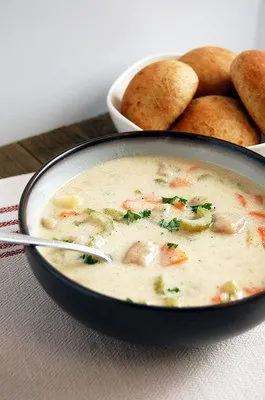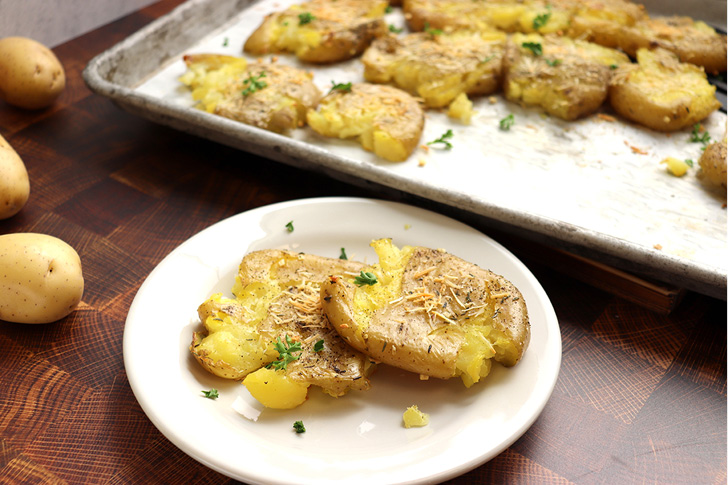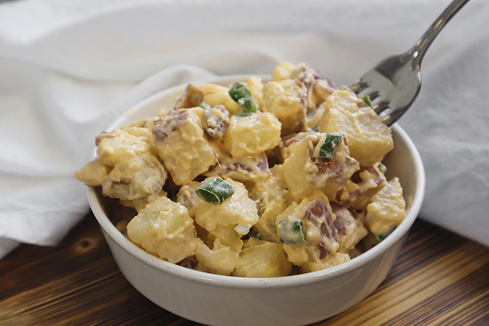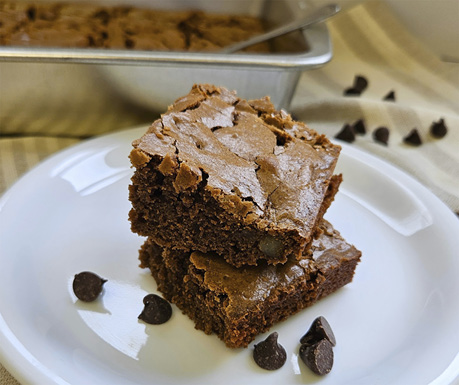Cooking Abbreviations: tsp. = teaspoon • Tbsp. = tablespoon • g = gram • mg = milligram • oz. = ounce • lb. = pound • pt. = pint • qt. = quart • pkg. = package
Knoephla Soup
¼ c. butter, unsalted
6 c. baking potatoes (about 3 large), peeled and cubed
½ c. onion (about 1 small onion), diced
¾ c. celery, diced
¾ c. carrot, diced
½ tsp. pepper (or to taste)
3 c. whole milk
6 c. chicken broth, lower sodium
Knoephla Dumplings
¾ c. whole wheat flour (or all-purpose flour)
¾ c. all-purpose flour
7 Tbsp. whole milk (or more as needed)
1 egg
2 tsp. dill weed
2 tsp. parsley
½ tsp. ground black pepper (or to taste)
½ tsp. salt
In large skillet, melt butter over medium heat. Sauté potatoes, onion, celery, carrot, and pepper until vegetables are tender, about 20 minutes. Stir 3 cups milk into potato mixture and heat until almost boiling, about 5 minutes. Remove skillet from heat. In a separate pot, bring chicken broth to a boil.
To make Knoephla Dumplings
Combine whole wheat and all-purpose flour, 7 tablespoons milk, egg, dill, parsley, pepper and salt. Add more milk a tablespoon at a time until dough is stiff. Roll dough into ½-inch thick ropes. Cut ropes into ¼-inch pieces with a knife or kitchen shears. Drop pieces into boiling broth, Cover pot and reduce heat to simmer until knoephla dumplings begin to float, about 10 minutes. Stir potato mixture into broth and knoephla dumplings. Simmer until potatoes are tender.
Makes 10 (1 cup) servings. Each serving had 260 calories, 8 g fat, 9 g protein, 39 g carbohydrate, 3 g fiber and 480 mg sodium.
Baked Potatoes
6 russet potatoes
1-2 tsp. melted butter
Salt to taste
Preheat oven to 450 F. Line baking sheet with foil. Wash potatoes, making sure all dirt is removed. Using a fork or knife, poke potatoes on all sides. Place potatoes on the baking sheet. Bake for 25 minutes. Remove from oven. With a pastry brush, brush the potatoes with melted butter until completely coated on all sides. Sprinkle the potatoes with a pinch of salt on all sides. Place the potatoes back on the baking sheet reverse side up. Bake an additional 20 minutes. Using an oven mitt, gently squeeze a potato to check for doneness. It should be soft. If not done, continue baking in 5-minute increments until potatoes are soft to squeeze. Using a small paring knife, slice halfway through the potato lengthwise. Place desired toppings in and on the opening.
Baked Potato Toppings
Cheese: mozzarella, cheddar, Mexican four cheese, cottage
Vegetables: chives, avocado, broccoli, mushrooms, tomatoes, peppers, black olives, cilantro
Meats: bacon bits, pulled pork, ground beef, shredded chicken
Makes six potatoes. Each potato without toppings has 120 calories, 1.5 g fat, 3 g protein, 26 g carbohydrate, 2 g fiber and 10 mg sodium.
Garlic Smashed Potatoes
1 lb. baby red potatoes (or use Yukon Gold or fingerling potatoes)
Pinch of salt
4 Tbsp. butter, melted
2 cloves garlic, minced
1 tsp. fresh thyme leaves
Freshly ground black pepper to taste
½ c. freshly grated Parmesan cheese
Preheat oven to 425 F. In a large pot, cover potatoes with water and add a pinch of salt. Bring water to a boil and simmer until potatoes are tender, about 15 minutes. Drain and let sit until cool enough to handle. On a large, rimmed baking sheet, toss potatoes with melted butter, minced garlic and thyme leaves. Using the bottom of a small drinking glass or mason jar, press down on potatoes to smash them into flat patties. Season with salt and pepper, then sprinkle with Parmesan. Bake until bottoms of potatoes are beginning to crisp and Parmesan is golden, about 25 minutes.
Makes six servings. Each serving has 160 calories, 10 g fat, 4 g protein, 15 g carbohydrate, 2 g fiber and 220 mg sodium.
Vegetable Chowder
1 c. onion, diced
1 c. celery, diced
¼ c. butter or margarine
1 c. carrots, cubed or cut into buttons
4 large potatoes (Yukon Gold, Russet or Red), rinsed and cubed
4 chicken bouillon cubes
5 c. reduced-sodium chicken stock
1 (13-oz.) can evaporated milk
2 c. frozen corn, thawed and drained
12 strips bacon, cooked and crumbled
Salt and pepper to taste
In a large pot over medium high heat, cook onion and celery in butter or margarine, stirring often until onion is translucent and beginning to brown. Add carrots, potatoes, bouillon cubes and stock. Bring to a boil, then reduce heat and simmer, stirring occasionally, to blend flavors. When vegetables are tender, add the evaporated milk, corn and bacon. Let simmer for a few minutes, then serve.
Optional: sprinkle shredded cheddar cheese over the top.
Makes 14 servings. Each serving has 290 calories, 16 g fat, 9 g protein, 28 g carbohydrate, 3 g fiber and 490 mg sodium.
Buffalo Potato Salad
1½ lbs. small red potatoes
¼ c. diced red bell pepper
¼ c. light mayonnaise
2 Tbsp. Greek yogurt
2-3 Tbsp. hot sauce
1 tsp. apple cider vinegar
¼ tsp. garlic powder
½ tsp. salt
c tsp. ground black pepper
4 green onions, chopped
Wash potatoes and add them to a large pot with water. Boil for about 20 minutes until the potatoes are fork tender. Remove the potatoes from the water, allow to cool and cut potatoes into small pieces. Add red pepper and potatoes to large bowl. In a small bowl, mix mayonnaise, yogurt, hot sauce, apple cider vinegar and spices together. Add this mixture to potatoes and red peppers. Stir and add chopped green onions. Chill before serving.
Makes four servings. Each serving has 180 calories, 5 g fat, 4 g protein, 30 g carbohydrate, 3 g fiber and 610 mg sodium.
Breakfast Potatoes
1½ lbs. russet potatoes
½ red pepper, diced
½ green pepper, diced
2 Tbsp. butter, melted
2 Tbsp. oil, such as canola, sunflower or olive
1 tsp. minced garlic
½ tsp. garlic powder
½ tsp. onion powder
¼ tsp. paprika
1 Tbsp. Italian seasoning
Salt and pepper to taste
Preheat oven to 400 F. Soak potatoes in cold water for 10 minutes to loosen dirt. Use a vegetable brush to remove excess dirt from potatoes. Dice potatoes into ½- to 1-inch pieces. Add butter, oil and spices to a bowl. Add potatoes. Stir to coat potatoes with mixture. Place coated potatoes on a sheet pan and bake 25 minutes at 400 F. While potatoes are in the oven, heat olive oil in a skillet. Add peppers, sautéing until soft. Combine with potatoes.
Optional additions: sauteed onions, shredded cheese of choice, chives, rosemary, thyme
Makes six servings. Without added salt, each serving has 160 calories, 8 g fat, 4 g protein, 23 g carbohydrate, 4 g fiber and 15 mg sodium.
Potato Brownies
1 ⅔ c. sugar
¼ tsp. salt
1 c. flour
1 c. mashed potatoes
1 ½ c. semisweet chocolate chips
¾ c. butter or margarine
1 tsp. vanilla extract
4 eggs
½ tsp. baking powder
Powdered sugar
Preheat oven to 350 F. In a saucepan, melt chocolate and butter/margarine on stove (or in a glass dish in the microwave). Cool slightly. Cream sugar, vanilla, salt and eggs. Add chocolate mixture and potatoes, flour and baking powder. Beat until creamy. Pour into a greased and floured 9-by13-inch cake pan. Bake at 350 F for around 30 minutes. Let cool. Sprinkle powdered sugar on top.
Makes 24 brownies. Each brownie has 200 calories, 10 g fat, 2 g protein, 26 g carbohydrate, 1 g fiber and 170 mg sodium.
Broccoli and Cheddar Potato Tots
5 small red potatoes
1 Tbsp. all-purpose flour
1 tsp. garlic powder
1 tsp. onion powder
1 tsp. dried parsley
½ tsp. ground black pepper
1 c. fresh broccoli, chopped
¾ c. shredded cheddar cheese
3 Tbsp. olive oil
Line a baking sheet with parchment paper. Peel potatoes and place in a large pot, covered with water. Bring to a boil and let the potatoes boil for 5-7 minutes, until fork tender. Remove potatoes and let cool. Once cool, grate the potatoes in a large bowl and remove excess water.
Preheat oven to 350 F. Add flour, garlic powder, onion powder, parsley and black pepper to the bowl. Mix until a thick dough-like texture forms. Set aside.
In a food processor, chop broccoli into very small pieces. Add broccoli and cheese to the potato mixture and mix until evenly dispersed. Using your hands, mold heaping tablespoons of the mixture into a rectangular, tot-like shape and place on a plate.
Add olive oil to a large pan over medium-high heat. Add tots and cook for 5-6 minutes, until golden brown. Flip and cook for another 2-3 minutes until browned. Transfer tots to the parchment-lined baking sheet and bake in the preheated oven for 10 minutes.
Makes six servings. Each serving has 210 calories, 16 g fat, 6 g protein, 14 g carbohydrate, 1 g fiber and 280 mg sodium.
All recipe photos are from NDSU. All other photos are from iStock.com.
Funding for this project was made possible by the U.S. Department of Agriculture’s Agricultural Marketing Service through grant 21SCBPND1069. Its contents are solely the responsibility of the authors and do not necessarily represent the official views of the USDA.
NDSU Extension does not endorse commercial products or companies even though reference may be made to tradenames, trademarks or service names.
For more information, see www.ag.ndsu.edu/food
County commissions, North Dakota State University and U.S. Department of Agriculture cooperating. NDSU does not discriminate in its programs and activities on the basis of age, color, gender expression/identity, genetic information, marital status, national origin, participation in lawful off-campus activity, physical or mental disability, pregnancy, public assistance status, race, religion, sex, sexual orientation, spousal relationship to current employee, or veteran status, as applicable. Direct inquiries to Vice Provost, Title IX/ADA Coordinator, Old Main 100, 701-231-7708, ndsu.eoaa@ndsu.edu. This publication will be made available in alternative formats for people with disabilities upon request, 701-231-7881. 2.4M-6-24





